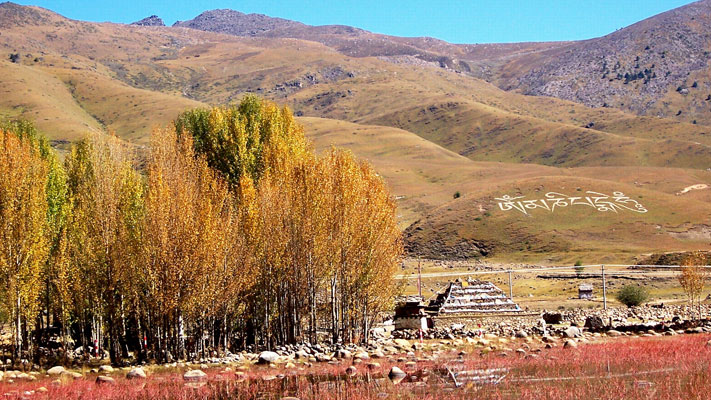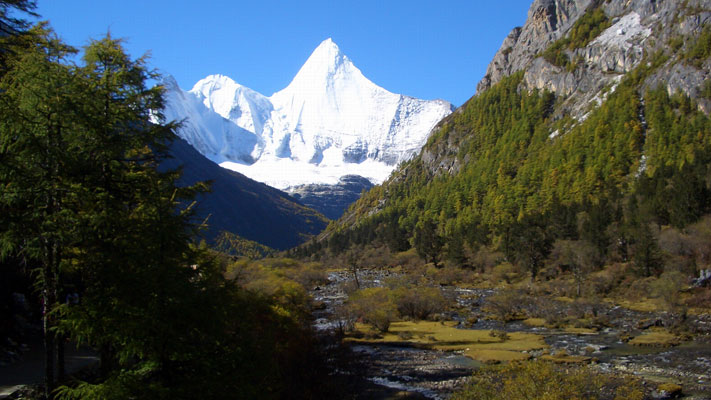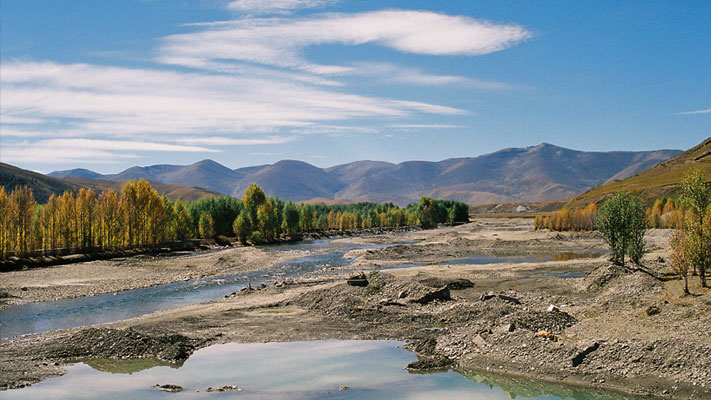The Fall to Lost Shangri-La in Sichuan - Gantse Tibetan Autonomous Region
I had just come back from a great trip with 7 friends to Sichuan. People keep asking me where I went and when I say Dao Cheng, Ya Ding, it all drew a blank on their faces. Only when I say it's one of the sites reputed to be Shangri La then they say "OHHHHH!!!". One of my friends commented that it's sad that they had to promote this place to tourists using this name which is being published in a Western book instead of using their Chinese name. I guess they felt that this was a faster way to promote this remote and beautiful place to the outside world. I'm really glad I came now instead of it being commercialised in the future.
To be exact, the place I went to is in Gan Zi Zhou Tibetan Autonomous Region in Sichuan during autumn. It's along the way to Tibet from Sichuan. Most of the populations are Tibetan but they all know how to speak Mandarin, which is also their common language since even amongst Tibetans, they have different dialects. Even thfe ood that they eat are mostly Sichuan dishes, spicy and oily instead of the typical Tibetan food dough. But they do drink Su You Tea (ie tea that tastes like saltish milk).
Although they are well-immmersed in Chinese Sichuan dishes and language, they are still very religious. Along the way, we see Tibetan pagodas, Tibetan scripture flags, Tibetan sacred stones, lama temples, lamas, etc. Small colourful Tibetan scripture flags are a common sight as it was said that whenever the wind blows the flags printed with scriptures, it would represent them reading their prayers once. Tibetan bells are also seen as each turn of the bell incripted with scriptures clockwise would represent prayers being read once. This is very useful especially for illiterate Tibetans since they can just push the bells to read their prayers. Tibetans had to do things clockwise hence, even during festivals, they had to walk around the sacred stones, pagodas or sacred mountains clockwise. It was also believed that 7 is a lucky no for Tibetans as Buddha gained enlightenment in 49 days (7 x 7). The lama temples we've been to are all of the yellow sect. I understand from my friend that lamas have different sects (yellow, red, white, black) each differentiated by their costumes.
Their architecture has a definite Tibetan flavour to it. Usually, it's two-three floors. The bottom floor houses their animals, like pigs. Their roof tops are flat. In one village, we even saw cow dungs being dried on the walls for fuel purpose.
As for animals, we see horses, lambs and yaks (hairy oxes) grazing freely on the mountain grassland. Initially, I thought they are wildlife but according to the guide, they belong to the villagers and have markings to identify their animals. They are being let out in the morning to graze and then shepherded back home in the evening.
In one of the town that we've been to, we also saw ladies working but the guys seem to be lazing around. According to the driver, some Tibetan towns still have the culture whereby ladies have to toil the land and men just laze around. In fact, he was telling us that in some older tribes, they even stuck to the old nomadic culture of having men going around to have babies with different ladies. WOW! Guys, you should all go to Tibet and be a convert.
Besides the people, of course, our awe was for the scenery there. The main places where we stopped are Hai Luo Gou Valley, Dao Cheng, Ya Ding, Xin Du Qiao and Si Gu Niang (Four Sisters) Mountain.

Hai Luo Gou Valley
This place is well known for its glacier, one of the lowest altitude glaciers in the world. The cable car ride up Hai Luo Gou would enable us to view the glacier and its crevices. One of the locals told me that some people actually fell into the crevices while climbing it and were never seen. Hence, it's now off limits to tourists to climb the glacier. In addition, at the cable stop, we can catch a view of the grand Gong Ga Mountain (Gong Ga means snow white in Tibetan language). It's the tallest peak in Sichuan at 7556M, hence named "Shu Shan Zi Wang".
Besides the glacier and Gong Ga Mountain, Hai Luo Gou valley also has well-known hot sulphuric springs. We tried to be adventurous but the highest degree that we can immerse ourselves in is 40 degree celsius. It goes all the way up to over 60 degree celsius. Hai Luo Gou Valley also has natural forests for conservation. It is one of the rare sights where glacier actually flows into the forests.

Dao Cheng
This place is famous for its yellow trees and red grasses especially during autumn. It was an ardous journey to Dao Cheng. Bumpy all the way and we had to cross around 9 mountains which are more than 4000M in altitude. Most of us started to have altitude sickness despite drinking the Hong Jing Tian and Ji Gang, Chinese medicine to help altitude sickness. Only two of the eight of us was ok. We all had headaches and one of my poor gal friends vomited. At one of the night stay at Li Tang, which is one of the tallest towns in the world at over 4000M, it was the very first time in my life that I experienced insomnia. It was very bad with pounding headaches throughout the night. In fact, most of us cannot sleep that night. I had to try talking to my room mate as somehow talking helps to relieve the pounding headache..Glad it was over now.. Think after that, we all got used to the high altitude and everyone was fine after that.
The view of all the mountains above 4000M on our way was also spectacular with clear blue skys, clouds in batches and snow peaks. Scientists even found dinosaur fossils in one of these mountains at Hai Zi Mountain.

Ya Ding
I would say the most spectacular scenery is at Ya Ding. At our cable car ride at Hai Luo Gou Valley, the locals have already started telling us about it. Even the lamas at temples asked us whether we are going to Ya ding. This is because Ya Ding is the Tibetan sacred ground as there lies the three sacred peaks, Xian Nai Ri (6032M), Yang Mai Yong (5958M) and Xia Nuo Duo Ji (5958M) . The three peaks are said to represent Guan Yin Buddha, Wen shu Buddha and Jing Gang Buddha respectively by the Tibetans. We rode horses up Ya Ding with a horse master each. It was very safe especially for me since my horse just refuses to gallop.. It's amazing how the local horse master can take the trek up Ya Ding since the air is thin at high altitude. We are glad we have the horses.
However, there is one setback of riding horses. We cannot stop and take pictures as we like. In addition, during one unpleasant incident, the horse masters ignore our guide's instructions to stop the horses at Cong Gu Temple scenic spot and our poor guide Lai Shi Fu (who were on foot all the way with us) was rushing all the way down by foot to stop the horses. In the end, most of my travel mates had to climb up on foot to Cong Gu temple while I'm the lucky two whom Lai Shi Fu managed to stop the horses on time at Cong Gu Temple. Salute to our Lai Shi Fu who walked all the way.
In fact, we were lucky we stopped. Spectacular views were taken at Cong Gu Temple scenic stop, with reflections of the snow peaks, sacred Tibetan stone stacks, Xian Nai Ri and Zhen Zhu Hai lake view.

Xin Du Qiao
This is said to be photographers' paradise of shadow and light. However, a sad thing was that when we were there that day, the day was cloudy and hence, not very sunny. As a result, some of the reflections wasn't very nice. But we did manage to capture some sunlight and shadows cast by the mountains. Along the way, we saw some professional photographers taking their tripods and waiting for the right moment. We of course, being the typical Kiasu Singaporeans, rushed to where they stand and tried to take similar angle since professional photographers would have the correct angle. They were very nice in fact. They actually tell us where to stand and even greeted us when they saw us following their car to wherever they stopped.. Who says mainland Chinese are uncouth? We met some nice ones on this trip. But I really salute the photographers' patience to stand and wait at the same spot just for the right sunlight to appear.
Si Gu Niang (Four Sisters) Mountain
This sacred Tibetan mountain is so named for its four peaks. The tallest is the fourth sister at 6250M, third at 5664M, second at 5454M and the eldest at 5355M. There is a Tibetan legend that these four sisters actually turned themselves into tall peaks to stamp down their foot onto a demon who is terrorising the villagers. Hence, till now, Tibetan treat this as a sacred mountain. Si Gu niang mountain is the second tallest peak in Sichuan after Gong Ga mountain and hence, also named queen of the mountains.
There are three scenic valleys in this mountain. We went to two of them, Shuang Qiao Gou and Chang Ping Gou. The third valley which we do not have time to go is Hai Zi Gou which would require one whole day. The views are very beautiful, with rare yellow trees (bai shu), clear blue sky, snow mountain, Ku Shu (rotting Trees) lake, etc. It's a pity at Chang Ping Gou, we were not able to go all the way to the top to see the green pasture near Si Gu Niang mountain as it would require staying overnight. This time at Chang Ping Gou, we also trek amidst the forests to see the views instead of horse back riding, which is another option for tourists. But the cool and dry weather makes the trek a breeze though the thin air tends to make me breathe heavier.

Pandas at Wo Long
On our way back to Cheng Du, we stopped at Wo Long Panda preservation centre. This is where pandas are kept close to nature at mountainside and then protected and observed. Sichuan is Pandas' hometown. I've been to Chengdu's Panda preservation centre to see pandas three times already. This is the first time I've been to the one at Wo long. Actually, although the one in Chengdu is bigger, but I prefer the one at Wo Long as it's just at the mountainside. The air is fresher. I find the pandas here cuter as they tend to be more active compared to the ones at Chengdu. Wonder if it's the air... Nevertheless, pandas never fail to fascinate me as they are so docile, slow moving and really looks like a big soft cuddly toy. Guess everyone knows the joke that Pandas' regret is that they are not able to take coloured photos..
My Thoughts
It's been an eye opener on this trip. Although I've been to China every year, seen lots of snow mountains and scenic places in China, this trip actually opens me up to the Tibetan culture. This is the first time that I've been to a Tibetan Autonomous region. The impression I have of the people here is that they are in general quite friendly. Of course, I've met those Tibetan people, even kids who asked me for money when I tried to take photos of their lambs. We also met kids who asked us for sweets. Sometimes, it's a bit sad that even the villagers are starting to be more materialistic when we see how the horse masters at Ya Ding feigned ignorance and did not stop at the designated stop as they need to rush back to base camp to get more customers. But that's the way of life.
That being said, most of the time on this trip, I've met nice people around. Professional photographers from China who do not mind us novices taking pointers from them, mainland tourists from Guangzhou who told us more about the land in a shared cable car ride with them. Shy and smiling Tibetans who willingly posed for photos and invited us to their tentage for a cup of tea. Our friendly driver cum guide who supervised kitchens to make sure the meals we ate are all tasty. In fact, he made an effort to change a variety of dishes, no mean feat especially since we are having eight dishes and one soup every meal. And of course our pretty guide who though cannot accompany us along the way but did try to make sure all is in place. Actually, China people are not as bad as what others think as uncouth.. Maybe I'm lucky but I think it's just their culture. One thing is for sure, the China people I know so far are definitely warm and friendly and loves to make friends all over...
I am also glad that we do not see a lot of tourists on this trip as that would mean we had to queue up for photos. So far, most of the groups we encountered are from Guangzhou, Hong Kong and Taiwan. I'm sure as this land opens up, more and more people would be coming.. it's now time for me to think about other untouched places to go to in China, the vast land of our ancestors...
Chrystal signs off (Singapore)

